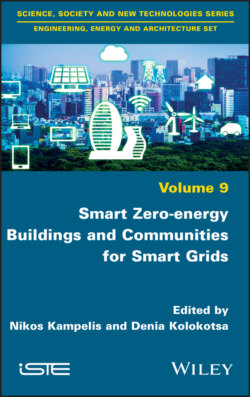Читать книгу Smart Zero-energy Buildings and Communities for Smart Grids - Группа авторов - Страница 2
Table of Contents
Оглавление1 Cover
2 Title Page
3 Copyright
4 Preface
5 List of Acronyms
6 1 The Role of Smart Grids in the Building Sector 1.1. Smart and zero-energy buildings 1.2. Smart and zero-energy communities 1.3. Conclusion and future prospects
7 2 Integrated Design (ID) Towards Smart Zero-energy Buildings and Smart Grids 2.1. Introduction 2.2. Methodology 2.3. Integrated design in smart and zero-energy buildings 2.4. ID process principles and guidelines 2.5. Scope of services 2.6. Remuneration models 2.7. Application of evaluation tools 2.8. Sustainability certification 2.9. Consultancy and quality assurance 2.10. Measurement of design quality criteria 2.11. Defining a client’s objectives 2.12. Defining the tenant’s objectives 2.13. Best practice sites
8 3 Data Analysis and Energy Modeling in Smart and Zero-energy Buildings and Communities 3.1. Energy signature for the NTL of Cyprus Institute 3.2. Athalassa Campus and the NTL building 3.3. Linear Fresnel solar collector at the NTL building, Cyprus Institute 3.4. Conclusion
9 4 On the Comparison of Occupancy in Relation to Energy Consumption and Indoor Environmental Quality: A Case Study 4.1. Introduction 4.2. Methodology 4.3. Description of the case building 4.4. Description of the experimental procedure 4.5. Results 4.6. Discussion and concluding remarks
10 5 Indoor Environmental Quality and Energy Consumption Assessment and ANN Predictions for an Integrated Internet-based Energy Management System Towards a Zero-energy Building 5.1. Introduction 5.2. Description of the SDE buildings 5.3. The power loads and hourly energy consumption 5.4. Indoor environmental quality 5.5. Cross correlation 5.6. Prediction using artificial neural networks (ANN) 5.7. Specifications for an integrated internet-based energy management system towards a zero-energy building 5.8. Conclusion
11 6 Objective and Subjective Evaluation of Thermal Comfort in the Loccioni Leaf Lab, Italy 6.1. Introduction 6.2. Background information 6.3. Methodology 6.4. Collection of building background data 6.5. Collection of monitored data 6.6. Right-Now questionnaire survey 6.7. Results 6.8. Conclusion
12 7 Smart Meters and User Engagement in the Leaf House 7.1. Introduction 7.2. Methodology 7.3. Analysis of user engagement 7.4. Results 7.5. Conclusion
13 8 Integration of Energy Storage in Smart Communities and Smart Grids 8.1. Energy storage systems in smart grids 8.2. Energy storage and smart grids: case studies 8.3. Conclusion and future prospects
14 Conclusion and Recommendations
15 References
16 List of Authors
17 Index
18 End User License Agreement
